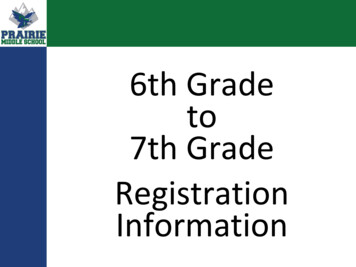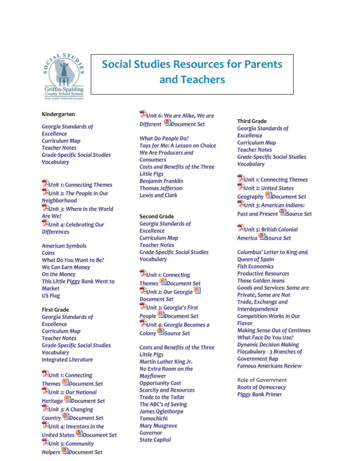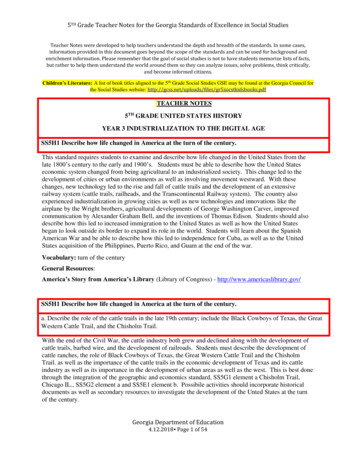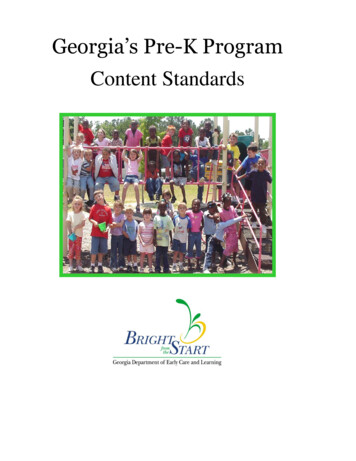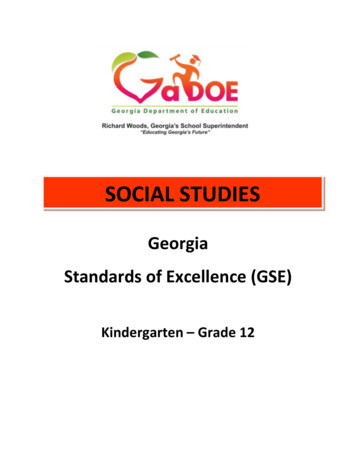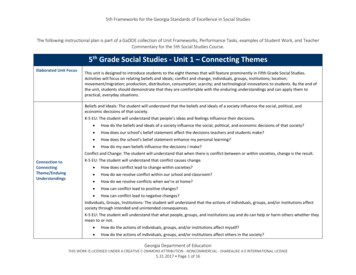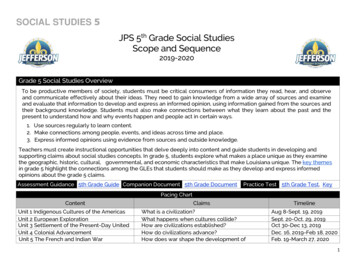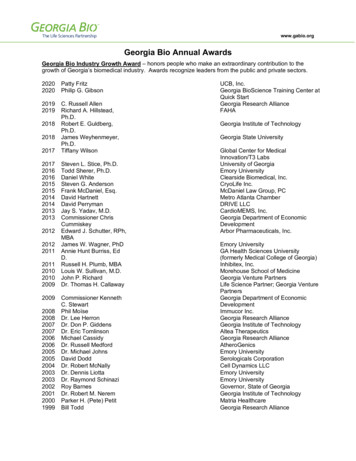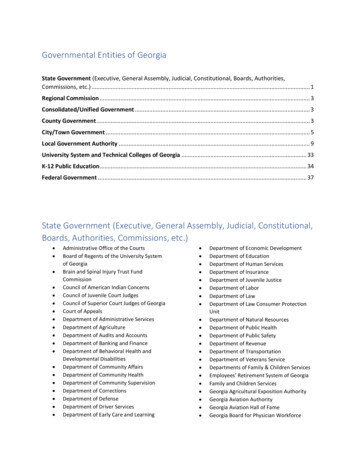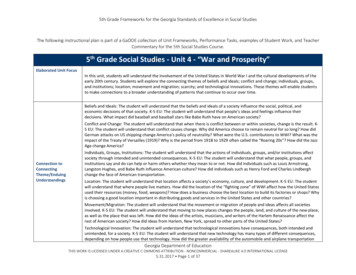
Transcription
5th Grade Frameworks for the Georgia Standards of Excellence in Social StudiesThe following instructional plan is part of a GaDOE collection of Unit Frameworks, Performance Tasks, examples of Student Work, and TeacherCommentary for the 5th Social Studies Course.5th Grade Social Studies - Unit 4 - “War and Prosperity”Elaborated Unit FocusIn this unit, students will understand the involvement of the United States in World War I and the cultural developments of theearly 20th century. Students will explore the connecting themes of beliefs and ideals; conflict and change; individuals, groups,and institutions; location; movement and migration; scarcity; and technological innovations. These themes will enable studentsto make connections to a broader understanding of patterns that continue to occur over time.Beliefs and Ideals: The student will understand that the beliefs and ideals of a society influence the social, political, andeconomic decisions of that society. K-5 EU: The student will understand that people’s ideas and feelings influence theirdecisions. What impact did baseball and baseball stars like Babe Ruth have on American society?Conflict and Change: The student will understand that when there is conflict between or within societies, change is the result. K5 EU: The student will understand that conflict causes change. Why did America choose to remain neutral for so long? How didGerman attacks on US shipping change America’s policy of neutrality? What were the U.S. contributions to WWI? What was theimpact of the Treaty of Versailles (1919)? Why is the period from 1918 to 1929 often called the “Roaring 20s”? How did the JazzAge change America?Connection , Groups, Institutions: The student will understand that the actions of individuals, groups, and/or institutions affectsociety through intended and unintended consequences. K-5 EU: The student will understand that what people, groups, andinstitutions say and do can help or harm others whether they mean to or not. How did individuals such as Louis Armstrong,Langston Hughes, and Babe Ruth influence American culture? How did individuals such as Henry Ford and Charles Lindberghchange the face of American transportation.Location: The student will understand that location affects a society’s economy, culture, and development. K-5 EU: The studentwill understand that where people live matters. How did the location of the “fighting zone” of WWI affect how the United Statesused their resources (money, food, weapons)? How does a business choose the best location to build its factories or shops? Whyis choosing a good location important in distributing goods and services in the United States and other countries?Movement/Migration: The student will understand that the movement or migration of people and ideas affects all societiesinvolved. K-5 EU: The student will understand that moving to new places changes the people, land, and culture of the new place,as well as the place that was left. How did the ideas of the artists, musicians, and writers of the Harlem Renaissance affect therest of American society? How did ideas from Harlem, New York, spread to other parts of the United States?Technological Innovation: The student will understand that technological innovations have consequences, both intended andunintended, for a society. K-5 EU: The student will understand that new technology has many types of different consequences,depending on how people use that technology. How did the greater availability of the automobile and airplane transportationGeorgia Department of EducationTHIS WORK IS LICENSED UNDER A CREATIVE C OMMONS ATTRIBUTION - NONCOMMERCIAL - SHAREALIKE 4.0 INTERNATIONAL LICENSE5.31.2017 Page 1 of 37
5th Grade Frameworks for the Georgia Standards of Excellence in Social Studiesaffect American society? What new technologies were created during the 1920s? How did these technological advancementschange the lives of Americans? How did technological advancements change American business?SS5H2 Describe U.S. involvement in World War I and post-World War I America.GSE for Social Studies(standards andelements)a. Explain how German attacks on U.S. shipping during the war in Europe (1914-1917) ultimately led the U.S. to join the fightagainst Germany; include the sinking of the Lusitania and concerns over safety of U.S. ships, U.S. contributions to the war, andthe impact of the Treaty of Versailles in 1919.b. Describe the cultural developments and individual contributions in the 1920s of the Jazz Age (Louis Armstrong), the HarlemRenaissance (Langston Hughes), baseball (Babe Ruth), the automobile (Henry Ford), and transatlantic flight (Charles Lindbergh).ELAGSE5RI7: Draw on information from multiple print or digital sources, demonstrating the ability to locate an answer to aquestion quickly or to solve a problem efficiently.ELAGSE5RI6: Analyze multiple accounts of the same event or topic, noting important similarities and differences in the point ofview they represent.ELAGSE5W1: Write opinion pieces on topics or texts, supporting a point of view with reasonsConnections to GSE forELA/Science/Math forGrade 5ELAGSE5RI9: Integrate information from several texts on the same topic in order to write or speak about the subjectknowledgeably.ELAGSE5RL2: Determine a theme of a story, drama, or poem from details in the text, including how characters in a story ordrama respond to challenges or how the speaker in a poem reflects upon a topic; summarize the textELAGSE5RL6: Describe how a narrator’s or speaker’s point of view influences how events are described.ELAGSE5W7: Conduct short research projects that use several sources to build knowledge through investigation of differentaspects of a topic.ELAGSE5W3: Write narratives to develop real or imagined experiences or events using effective technique, descriptive details,and clear event sequences.ELAGSE5W8: Recall relevant information from experiences or gather relevant information from print and digital sources;Georgia Department of EducationTHIS WORK IS LICENSED UNDER A CREATIVE C OMMONS ATTRIBUTION - NONCOMMERCIAL - SHAREALIKE 4.0 INTERNATIONAL LICENSE5.31.2017 Page 2 of 37
5th Grade Frameworks for the Georgia Standards of Excellence in Social Studiessummarize or paraphrase information in notes and finished work, and provide a list of sources.Map and Globe Skills:Connection to SocialStudies Matrices(informationprocessing and/or mapand globe skills) use map key/legend to acquire information from historical, physical, political, resource, product, and economic maps draw conclusions and make generalizations based on information from maps compare maps of the same place at different points in time and from different perspectives to determine changes,identify trends, and generalize about human activities use a map to explain impact of geography on historical and current events use intermediate directionsInformation Processing Skills: identify issues and/or problems and alternative solutions identify and use primary and secondary sources interpret timelines draw conclusions and make generalizations analyze graphs and diagrams identify social studies reference resources to use for a specific purpose analyze artifactsGeorgia Department of EducationTHIS WORK IS LICENSED UNDER A CREATIVE C OMMONS ATTRIBUTION - NONCOMMERCIAL - SHAREALIKE 4.0 INTERNATIONAL LICENSE5.31.2017 Page 3 of 37
5th Grade Frameworks for the Georgia Standards of Excellence in Social StudiesEssential Questions and Related Supporting/Guiding Questions1.Essential Question 12.Essential Question 23.Essential Question 3Was it necessary for the U.S. to enter World War I?a.Why did the U.S. stay out of World War I for so long?b.What influenced the U.S. to join World War I?c.How did the U.S. fare in the outcome of World War I?What led to the 1920s being known as the “Roaring 20s”?a.How did the economy change for U.S. citizens during the 1920s?b.What cultural changes took place in the 1920s?c.Were the 1920s a good time for all U.S. citizens?How did life change for African-Americans or Blacks in the 1920s?a. What led African-Americans or Blacks to migrate to the cities?b. How did the Harlem Renaissance affect African-American or Black attitudes of the U.S.?c. What experiences influenced artists during the Harlem Renaissance?Georgia Department of EducationTHIS WORK IS LICENSED UNDER A CREATIVE C OMMONS ATTRIBUTION - NONCOMMERCIAL - SHAREALIKE 4.0 INTERNATIONAL LICENSE5.31.2017 Page 4 of 37
5th Grade Frameworks for the Georgia Standards of Excellence in Social StudiesSample Instructional Activities/AssessmentsThe War to End all Wars?Description –1.Play the following video: https://www.youtube.com/watch?v DpuOa6u6HX0. Before watching the video ask students to try to identify one causeof World War I.2.Have student view the World War I map. (following this activity)3.Have students identify the countries that were working together and those they were fighting against.4.Watch the next video clip: https://www.youtube.com/watch?v qzzXPkAdQXQ5.Ask the students why this war was called a world war.6.Point out that the U.S. was not on the map or mentioned in either of the video clips.7.Ask students what the pros/cons would be of helping one of the sides in World War I. Make a list of the student responses.8.Tell students that the U.S. stayed out of World War I at the beginning, but still sent supplies and let people travel in ships to Europe. However,show the following stat of U.S. exports in 1914:1914 – 824.8 million to Allies/Triple Entente1914 – 169.3 million to Central Powers/Triple Alliance9.Ask students which side the U.S. might favor based upon the stat above and why.10. Have students think of one pro and one con of sending supplies and letting people travel to Britain.SS5H2 Describe U.S. involvement in World War I and post-World War I America.GSE Standards andElementsa. Explain how German attacks on U.S. shipping during the war in Europe (1914-1917) ultimately led the U.S. to join the fightagainst Germany; include the sinking of the Lusitania and concerns over safety of U.S. ships, U.S. contributions to the war, andthe impact of the Treaty of Versailles in 1919.Literacy StandardsSocial Studies MatricesELAGSE5RI7: Draw on information from multiple print or digital sources, demonstrating the ability to locate an answer to aquestion quickly or to solve a problem efficiently.EnduringUnderstanding(s)Information Processing Skills:Georgia Department of EducationTHIS WORK IS LICENSED UNDER A CREATIVE C OMMONS ATTRIBUTION - NONCOMMERCIAL - SHAREALIKE 4.0 INTERNATIONAL LICENSE5.31.2017 Page 5 of 37
5th Grade Frameworks for the Georgia Standards of Excellence in Social Studies compare similarities and differencesidentify issues and/or problems and alternative solutionsdraw conclusions and make generalizationsMap and Globe Skills: use map key/legend to acquire information from historical, physical, political, resource, product, and economic mapsdraw conclusions and make generalizations based on information from mapscompare maps of the same place at different points in time and from different perspectives to determine changes,identify trends, and generalize about human activitiesSee below for World War I map.Georgia Department of EducationTHIS WORK IS LICENSED UNDER A CREATIVE C OMMONS ATTRIBUTION - NONCOMMERCIAL - SHAREALIKE 4.0 INTERNATIONAL LICENSE5.31.2017 Page 6 of 37
5th Grade Frameworks for the Georgia Standards of Excellence in Social StudiesGeorgia Department of EducationTHIS WORK IS LICENSED UNDER A CREATIVE C OMMONS ATTRIBUTION - NONCOMMERCIAL - SHAREALIKE 4.0 INTERNATIONAL LICENSE5.31.2017 Page 7 of 37Public domain image
5th Grade Frameworks for the Georgia Standards of Excellence in Social StudiesDown Goes the ShipDescription –1.Show the following quote and have students discuss its meaning:“The United States must be neutral in fact, as well as in name, during these days that are to try men's souls. We must be impartial in thought, aswell as action, must put a curb upon our sentiments, as well as upon every transaction that might be construed as a preference of one party to thestruggle before another.”—President Wilson's Declaration of Neutrality August 19, 19142.Tell the students that many U.S. citizens were undecided as whether the U.S. should join the war and who to help.3.Display the Lusitania headline. (see accompanying ppt)4.Ask the students how the sinking of the Lusitania might change U.S. citizens’ opinion of our involvement in the war.5.Hand out the “When the Lusitania Went Down” lyrics and analysis sheet and you can play the actual song with the following link:https://www.youtube.com/watch?v 2cRaYYZzmVw (See below)6.Have the students work together to answer the questions.7.Have the students share their answers.8.Display the Lusitania propaganda picture and have students analyze the poster. (see accompanying ppt)9.Tell students that after the Lusitania was sunk many propaganda posters were made to influence U.S. citizens to join the war to help Britain andFrance.10. Have the students create a propaganda poster using the attached rubric. (See below.)Differentiation:Allow students to print out images to create the poster.Play the song to help those that have trouble reading the lyrics.SS5H2 Describe U.S. involvement in World War I and post-World War I America.GSE Standards andElementsLiteracy StandardsSocial Studies MatricesEnduringa. Explain how German attacks on U.S. shipping during the war in Europe (1914-1917) ultimately led the U.S. to join the fightagainst Germany; include the sinking of the Lusitania and concerns over safety of U.S. ships, U.S. contributions to the war, andthe impact of the Treaty of Versailles in 1919.ELAGSE5RI6: Analyze multiple accounts of the same event or topic, noting important similarities and differences in the point ofview they represent.Georgia Department of EducationTHIS WORK IS LICENSED UNDER A CREATIVE C OMMONS ATTRIBUTION - NONCOMMERCIAL - SHAREALIKE 4.0 INTERNATIONAL LICENSE5.31.2017 Page 8 of 37
5th Grade Frameworks for the Georgia Standards of Excellence in Social StudiesUnderstanding(s)ELAGSE5RI7: Draw on information from multiple print or digital sources, demonstrating the ability to locate an answer to aquestion quickly or to solve a problem efficiently.Information Processing Skills: identify and use primary and secondary sourcesidentify social studies reference resources to use for a specific purposeanalyze artifactsdraw conclusions and make generalizationsGeorgia Department of EducationTHIS WORK IS LICENSED UNDER A CREATIVE C OMMONS ATTRIBUTION - NONCOMMERCIAL - SHAREALIKE 4.0 INTERNATIONAL LICENSE5.31.2017 Page 9 of 37
5th Grade Frameworks for the Georgia Standards of Excellence in Social StudiesORLD NEvaluation RubricCATEGORY3 POINTS2 POINTS1 ndaTechniqueGrammarand SpellingNeatnessThe message of thisposter is clearlyidentifiable.The message of thisposter is clearlyidentifiable.The messageposter is notidentifiable.The messageposter is notidentifiable.of thisclearlyThe poster clearlydemonstrates the useof a propagandatechnique.The poster does notclearly demonstrate theuse of a propagandatechnique.The student makes noerrors in grammar orspelling that distractthe reader from thecontent of theposter.The student makes anumber of grammaticaland spelling errors thatminimally distract thereader from theposter’s content.The student makesmany grammaticaland spelling errorsthat distract thereader from theposter’s content.The poster uses color,visual images andwords to clearlycommunicate theposter’s intendedmessage. The poster isneat and cleanlypresented.The poster makes someuse of color, visualimages and words tocommunicate theposter’s intendedmessage. The poster islacking in overallneatness andpresentation.The poster does notuse color, visualimages or words tocommunicate theposter’s intendedmessage. The poster issloppy and poorlypresented.of thisclearlyNo clear message canbe identified on theposter.There was no clearlydefined target audiencefor thisposter.The posterdemonstrates nopropagandatechnique.TOTAL POINTS EARNED (15 points possible)Georgia Department of EducationTHIS WORK IS LICENSED UNDER A CREATIVE C OMMONS ATTRIBUTION - NONCOMMERCIAL - SHAREALIKE 4.0 INTERNATIONALLICENSE5.31.2017 Page 10 of 37
5th Grade Frameworks for the Georgia Standards of Excellence in Social StudiesWhen the Lusitania Went Down (1915)(Charles McCaroon and Nat Vincent)The nation is sad as can be,A message came over the sea.A thousand or more, who sailed from our shore,Have gone to eternity.The Statue of Liberty high,Must now have a tear in her eye.I think it’s a shame; no one is to blame,But all we can do is just sigh.Some of us lost a true sweetheart,Some of us lost a dear dad,Some lost their mothers, sisters and brothersSome lost the best friends they had.It’s time they were stopping this warfare,If women and children must cry.Many brave hearts went to sleep in the deep,When the Lusitania went down.Oh, listen to all these good deeds.When we feel like crossing the sea,American ships that sail from our slips,Are safer for you and me.Georgia Department of EducationTHIS WORK IS LICENSED UNDER A CREATIVE C OMMONS ATTRIBUTION - NONCOMMERCIAL - SHAREALIKE 4.0 INTERNATIONALLICENSE5.31.2017 Page 11 of 37
5th Grade Frameworks for the Georgia Standards of Excellence in Social StudiesA Yankee can go anywhereAs long as Old Glory is there.Although they were warned, the warning they scorned,And now we must cry in despair.(repeat third and fourth verses)Georgia Department of EducationTHIS WORK IS LICENSED UNDER A CREATIVE C OMMONS ATTRIBUTION - NONCOMMERCIAL - SHAREALIKE 4.0 INTERNATIONALLICENSE5.31.2017 Page 12 of 37
5th Grade Frameworks for the Georgia Standards of Excellence in Social StudiesName:Date:Song Analysis SheetWhat is the mood? Provide evidence to support your answer.What has happened? Provide evidence to support your answer.Who does the song blame for this event? Provide evidence to support your answer.Do the song give a solution to the problem? Support your answer with reasons.How do you think this song would have changed the opinion of U.S. citizens about joining the war?Support your answer with reasonGeorgia Department of EducationTHIS WORK IS LICENSED UNDER A CREATIVE C OMMONS ATTRIBUTION - NONCOMMERCIAL - SHAREALIKE 4.0 INTERNATIONALLICENSE5.31.2017 Page 13 of 37
5th Grade Frameworks for the Georgia Standards of Excellence in Social StudiesThe U.S. Joins the FightDescription –1.Have the students view the U.S. Joins the Fight timeline and analyze it using the guiding questions contained on the sheet. (See below)2.Have students share their opinion of which side the U.S. should join.3.Read Wilson’s War statement to the students. (See below)4.Have the students find reasons that President Wilson has given for the U.S. to join the war.5.Have students work in pairs to think of how the U.S. joining the war would help Britain and France.6.Have the students share to create a class list.7.Show the following video clip to students to review why the US went to war and how the US helped France and Britain win (note that this videomay start with ads): r-i-history/videos/the-us-in-world-war-i8.Have students write a brief paragraph describing how the world may have been different if the U.S. did not join the war.Differentiation:Students can give an oral answer instead of a written answer to the question.The analyzing timeline activity can be done in pairs or as a whole class.SS5H2 Describe U.S. involvement in World War I and post-World War I America.GSE Standards andElementsa. Explain how German attacks on U.S. shipping during the war in Europe (1914-1917) ultimately led the U.S. to join the fightagainst Germany; include the sinking of the Lusitania and concerns over safety of U.S. ships, U.S. contributions to the war, andthe impact of the Treaty of Versailles in 1919.ELAGSE5W1: Write opinion pieces on topics or texts, supporting a point of view with reasonsLiteracy StandardsSocial Studies MatricesEnduringUnderstanding(s)ELAGSE5RI6: Analyze multiple accounts of the same event or topic, noting important similarities and differences in the point ofview they represent.ELAGSE5RI9: Integrate information from several texts on the same topic in order to write or speak about the subjectknowledgeably.Georgia Department of EducationTHIS WORK IS LICENSED UNDER A CREATIVE C OMMONS ATTRIBUTION - NONCOMMERCIAL - SHAREALIKE 4.0 INTERNATIONAL LICENSE5.31.2017 Page 14 of 37
5th Grade Frameworks for the Georgia Standards of Excellence in Social StudiesInformation Processing Skills: identify issues and/or problems and alternative solutionsidentify and use primary and secondary sourcesinterpret timelinesdraw conclusions and make generalizationsGeorgia Department of EducationTHIS WORK IS LICENSED UNDER A CREATIVE C OMMONS ATTRIBUTION - NONCOMMERCIAL - SHAREALIKE 4.0 INTERNATIONAL LICENSE5.31.2017 Page 15 of 37
5th Grade Frameworks for the Georgia Standards of Excellence in Social StudiesU.S. and World War I Timeline & Analysis QuestionsAugust 19, 1914: President Wilson's Declaration of NeutralityThe United States must be neutral in fact, as well as in name, during these days that are to try men'ssouls. We must be impartial in thought, as well as action, must put a curb upon our sentiments, as well asupon every transaction that might be construed as a preference of one party to the struggle beforeanother.—President Wilson's Declaration of NeutralityFebruary 10, 1915: President Wilson's First Warning to the GermansIf such a deplorable situation should arise, the Imperial German Government can readily appreciate thatthe Government of the United States would be constrained to hold the Imperial Government of Germanyto a strict accountability for such acts of their naval authorities, and to take any steps it might benecessary to take to safeguard American lives and property and to secure to American citizens the fullenjoyment of their acknowledged rights on the high seas.May 7, 1915: Lusitania sunk by German U-BoatJuly 30, 1916: Jersey City, N.J., munitions plant destroyed; German sabotage suspected.October 15, 1916: Germany resumes U-boat attacks under "search and destroy" rules.November 9, 1916: Woodrow Wilson wins reelection under the slogan "He kept us out of war."Value of U.S. Exports for 1916:1916 – 3.2 billion to Allies 1916 – 1.2 million to Central PowersValue of U.S. Loans by 1917: 2.5 billion to Allies 27 million to Central PowersGeorgia Department of EducationTHIS WORK IS LICENSED UNDER A CREATIVE C OMMONS ATTRIBUTION - NONCOMMERCIAL - SHAREALIKE 4.0 INTERNATIONALLICENSE5.31.2017 Page 16 of 37
5th Grade Frameworks for the Georgia Standards of Excellence in Social StudiesFebruary 24, 1917: Great Britain releases Zimmermann Note to U.S.we propose an alliance on the following basis with Mexico: That we shall make war together andtogether make peace. We shall give general financial support, and it is understood that Mexico is to reconquer the lost territory in New Mexico, Texas, and Arizona.—From the German Secretary of State (Zimmerman) to the German Minister to MexicoU.S .Joins the Fight Guiding Questions1. What is President Wilson’s first stance about the involvement of the U.S. in World War I?2. Look at the U.S. exports and loans during the war. Do you think the U.S. is favoring one side?Why?3. If we are to join the war on one side, which side do you think the U.S. would support?4. Provide 2 – 3 reasons from the timeline that justify the side that we should support.1.2.Georgia Department of EducationTHIS WORK IS LICENSED UNDER A CREATIVE C OMMONS ATTRIBUTION - NONCOMMERCIAL - SHAREALIKE 4.0 INTERNATIONALLICENSE5.31.2017 Page 17 of 37
5th Grade Frameworks for the Georgia Standards of Excellence in Social StudiesWoodrow Wilson’s War Message I am not now thinking of the loss of property involved, immense and serious as that is, but only of thewanton and wholesale destruction of the lives of noncombatants, men, women, and children, engaged inpursuits which have always, even in the darkest periods of modern history, been deemed innocent andlegitimate. Property can be paid for; the lives of peaceful and innocent people can not be. The presentGerman submarine warfare against commerce is a warfare against mankind.It is a war against all nations. American ships have been sunk, American lives taken, in ways which it hasstirred us very deeply to learn of, but the ships and people of other neutral and friendly nations have beensunk and overwhelmed in the waters in the same way. There has been no discrimination. The challengeis to all mankind. Each nation must decide for itself how it will meet it. The choice we make for ourselvesmust be made with a moderation of counsel and a temperateness of judgment befitting our character andour motives as a nation. We must put excited feeling away. Our motive will not be revenge or thevictorious assertion of the physical might of the nation, but only the vindication of right, of human right, ofwhich we are only a single champion.—President Woodrow Wilson's War Message, April 2, 1917Georgia Department of EducationTHIS WORK IS LICENSED UNDER A CREATIVE C OMMONS ATTRIBUTION - NONCOMMERCIAL - SHAREALIKE 4.0 INTERNATIONALLICENSE5.31.2017 Page 18 of 37
5th Grade Frameworks for the Georgia Standards of Excellence in Social StudiesWho’s to Blame?Description –1.Hand out the following excerpts from the Treaty of Versailles (see below) and the Map of Europe after World War I (See accompanying ppt).2.Have the students work in groups to find answers using the question sheet.3.Have students share their answers once the activity is completed.4.Ask students how they would feel if they were German citizens and they were blamed for the war.5.Chart the responses.6.Have students make predictions on how these feelings could cause future problems.7.Chart the responses.Differentiation:Here is an interactive extension activity (note that this is from a British size/history/mwh/ir1/treatyact.shtmlHave the students research and find other ways the Germans were punished with the Treaty of VersaillesSS5H2 Describe U.S. involvement in World War I and post-World War I America.GSE Standards andElementsLiteracy StandardsSocial Studies MatricesEnduringUnderstanding(s)a. Explain how German attacks on U.S. shipping during the war in Europe (1914-1917) ultimately led the U.S. to join the fightagainst Germany; include the sinking of the Lusitania and concerns over safety of U.S. ships, U.S. contributions to the war, andthe impact of the Treaty of Versailles in 1919.ELAGSE5RI7: Draw on information from multiple print or digital sources, demonstrating the ability to locate an answer to aquestion quickly or to solve a problem efficiently.Information Processing Skills: identify and use primary and secondary sources draw conclusions and make generalizationsMap and Globe Skills: use a map to explain impact of geography on historical and current events compare maps of the same place at different points in time and from different perspectives to determine changes,identify trends, and generalize about human activitiesGeorgia Department of EducationTHIS WORK IS LICENSED UNDER A CREATIVE C OMMONS ATTRIBUTION - NONCOMMERCIAL - SHAREALIKE 4.0 INTERNATIONAL LICENSE5.31.2017 Page 19 of 37
5th Grade Frameworks for the Georgia Standards of Excellence in Social StudiesTreaty of Versailles Excerpts & Guiding QuestionsArticle 118In territory outside her European frontiers as fixed by the present Treaty, Germany renounces all rights,titles and privileges whatever in or over territory which belonged to her or to her allies, and all rights,titles and privileges whatever their origin which she held as against the Allied and Associated Powers.Article 119Germany renounces in favour of the Principal Allied and Associated Powers all her rights and titles overher oversea possessions.Article 160(1) By a date which must not be later than March 31, 1920, the German Army must not comprise morethan seven divisions of infantry and three divisions of cavalry.After that date the total number of effectives in the Army of the States constituting Germany must notexceed one hundred thousand men, including officers and establishments of depots. The Army shall bedevoted exclusively to the maintenance of order within the territory and to the control of the frontiers.Article 168The manufacture of arms, munitions, or any war material, shall only be carried out in factories or worksthe location of which shall be communicated to and approved by the Governments of the Principal Alliedand Associated Powers, and the number of which they retain the right to restrict.Article 181After the expiration of a period of two months from the coming into force of the present Treaty theGerman naval forces in commission must not exceed:6 battleships No submarines are to be included.Article 198The armed forces of Germany must not include any military or naval air forces.Article 231The Allied and Associated Governments affirm and Germany accepts the responsibility of Germany andher allies for causing all the loss and damage to which the Allied and Associated Governments and theirnationals have been subjected as a consequence of the war imposed upon them by the aggression ofGermany and her allies.Article 235Georgia Department of EducationTHIS WORK IS LICENSED UNDER A CREATIVE C OMMONS ATTRIBUTION - NONCOMMERCIAL - SHAREALIKE 4.0 INTERNATIONALLICENSE5.31.2017 Page 20 of 37
5th Grade Frameworks for the Georgia Standards of Excellence in Social Studies Germany shall pay in such installments and in such manner (whether in gold,
5.31.2017 Page 1 of 37 The following instructional plan is part of a GaDOE collection of Unit Frameworks, Performance Tasks, examples of Student Work, and Teacher Commentary for the 5th Social Studies Course. 5th Grade Social Studies - Unit 4 - “
